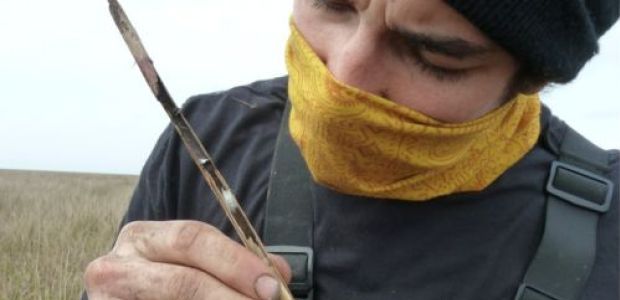
‘Slow Ride’ creators Foghat play Tarpon Rodeo
July 8, 2014Terrebonne school budget approved
July 9, 2014Increasing levels of certain toxins in Louisiana marshes – including some south of Cocodrie – are among the findings of LSU researchers examining effects of the Deepwater Horizon oil spill.
The toxins, entomologist Linda Hooper-Bui says, are believed responsible for the disappearance of some insect species from marshlands near Terrebonne Bay, Barataria Bay and other water bodies crucial to coastal habitat.
Those insects are among life forms essential to land and marine food chains, Hooper-Bui says, causing she and other scientists to conclude that effects of the 2010 Macondo well blowout are neither finished nor fully comprehended.
BP disputes the findings, which Hooper-Bui says have been peer reviewed and will soon be published.
But charter captains and commercial fishermen maintain the scenario Hooper-Bui’s research paints with what they have said all along, that oil was forced beneath the Gulf of Mexico’s surface during frantic cleanup efforts and can – in some form – later bloom with toxic effects.
“I am not a scientist,” said veteran charter captain Stu Scheer. “But we know something is wrong out there. Speckled trout are down. The fishing has gotten steadily worse since 2010.”
Scheer says the way he and other fishermen see it, the loss of a big slice of population from a generation of game fish, coupled with hard fishing in the years since, is making for a tougher comeback.
Scheer was not surprised by Hooper-Bui’s claims, which he said are cause for even greater concern.
While counting and cataloguing insects on the coast Hooper-Bui and her team placed crickets native to the marsh in floating houses, releasing them in previously oiled areas as well as in those not affected by oil, as a control.
Insects released in places previously affected by oil but considered cleaned – including Terrebonne Bay marshes – did not survive.
Research built on those findings, Hooper-Bui said, indicates that even as visible oil has lessened, toxic aromatic compounds have increased. Those are the products, she suspects, of oil remnants that sank sub-surface being stirred up by storms and other activity, as well as continued erosion of the marsh.
“What we think we know is that when we put the crickets out in the cages in the oiled areas and equivalent cages in unoiled areas, when the tide was blown and the water blown off the marsh and the air temperature was above 85 degrees, volatiles expelled from the sediment were high enough to kill the crickets,” Hooper-Bui said. “There is a problem in the marsh, there are volatile compounds. There are five, there may be more. What we found is that some of those volatile compounds have increased since the oil spill. They have not decreased, they are not going down and some of them seem to be accumulating. The marsh is not healthy.”
Various unknown factors could be contributing to the ultimate findings, Hooper-Bui and other scientists have acknowledged, although work is being done to more accurately determine causal factors, including more sensitive air sampling.
That researchers themselves acknowledge uncertainty is one reason BP spokesman Jason Ryan says there is reason for skepticism.
“The researchers acknowledged many unknowns related to their preliminary findings, including what process would cause levels of naphthalene and methyl-naphthalene to increase over time,” Ryan said Sunday, in an e-mailed response to questions about the research.
Extensive sampling and testing conducted in 2010 “indicates that weathering processes removed virtually all of these compounds from the Macondo oil before it made landfall,” he said. “The trace levels of naphthalene and methyl-naphthalene that remain in weathered Macondo oil are no different than background levels from other sources, and there is no known process that causes these compounds to spontaneously form from other oil constituents that are degrading.”
The LSU scientists say that while Ryan has indeed done his homework, the unanswered come from an abundance of caution being used. Additionally, the Macondo incident is taking scientists places where they have not gone before.
“Just because it is new science does not mean it is wrong,” Hooper-Bui said. “This is the most well-studied oil disaster so naturally, new unexplained phenomena will be discovered. We have carefully conducted experiments in the field and in the laboratory examining the issues from different perspectives and cannot present all of our methods and results in a short time a scientific conference allows. We report the independent science outcomes even if we cannot explain the cause at the moment. We continue to conduct independent research to seek answers to perplexing questions and will report the results regardless of the outcome.”
Insects LSU researchers have catalogued as disappearing from marshes include acrobat ants, several species of spiders and crickets. The scientists have samples of insects – benchmark data – from before the spill that help them know what change has occurred.
“If the marshes aren’t healthy, the insects are really a good indicator,” Hooper-Bui said, adding that the ill effects were charted as similar from shoreline into the marsh areas, as deep as 300 feet, using air quality measuring equipment.
“You can’t see it because it is blended into the sediment,” she said. “You cannot smell some of these toxic aromatics.”
Asphaltene and various paraffins, Hooper-Bui said, are not usually toxic and can be measured, and they are degrading.
But the more toxic elements, she said, are those that remain.
One factor being considered in the findings is that the degradation or erosion of marsh overall – especially in the Terrebonne Barataria areas – makes for a moving scientific target. As land is lost, the effects suspected of being from oil show up in areas previously not included in the surveys. And oiling of some marsh, Hooper-Bui suspects, is related to its disappearance.
“The marsh in Terrebonne Bay and Barataria Bay is very degraded,” she said. “The oiled areas we are losing have us very concerned about the Terrebonne Bay and Barataria Bay marsh.”
A paper to be published in the Marine Pollution Bulletin, an international journal of scientific studies, will focus primarily on the increase in harmful substances even as less harmful substances degrade or disappear.
“The aromatics, the very toxic compounds, are very stable,” Hooper-Bui said.
Told that her theories reflect those posited by fishermen shortly after the spill, Hooper-Bui said she is not surprised.
Considering herself a mere visitor to the marsh environment, Hooper-Bui notes that fishermen and others routinely in the outdoors of the marsh have knowledge born of experience to which attention should be paid.
“When a fisherman tells me something it gets my attention,” she said. “When other fishermen to whom that fisherman has not spoken tell me the same thing, I am gaining a knowledge base.”
Gerald Soderstrum examines a stem of cord grass while looking for insects among the pupa, the white, fuzzy part of the stem. LSU researchers examining the effects of the Deepwater Horizon oil spill blame increasing levels of certain toxins in Louisiana marshes for the insect decline.









